How to Schedule Facebook Posts: A Guide
No matter the size of your business, your marketing plan will certainly include posting content to Facebook.
With over two billion monthly active users, Facebook is the world’s water cooler. People go to Facebook to share experiences, shop for products, and discover new ideas. Businesses must have a consistent presence on this social network if they want to be where their customers hang out.
But that can become challenging and time consuming. To do Facebook right and keep up with audience demands requires a lot of dedication. And that’s why most businesses use automation tools to schedule their Facebook posts in advance.
Scheduling your posts will give you immediate paybacks, such as:
- Automation saves time
- Improved campaign performance
- Brand consistency
Should you schedule Facebook posts for your small business?
Consider these three very persuasive reasons why you should consider scheduling Facebook posts in your small business marketing strategy.
1. Automation saves time
Schedule Facebook posts in advance to stay on top of your social media content calendar. This will be a huge relief for social media managers, who typically deal with a wide range of marketing channels and content formats.
When you schedule your Facebook posts, you have time to focus on the creative aspects of your business, such as brand positioning and content creation.
2. Improved campaign performance
Manual social media posting offers an extra degree of control, but it comes with restrictions too.
For example, you may miss reaching people in multiple time zones and countries due to inconveniences like meals and sleep. It’s hard to manage an account 24 hours a day without digital assistance.
With automated Facebook posting, your posts can go live around the clock to cater to audiences across time zones. This broadens your reach and helps meet social media marketing kpis like clicks and shares.
3. Consistency
Planning your content in advance lets you build a brand that has consistency of tone across all content.
For example, you can carry out a social media audit to analyze the topics and content formats that typically perform best, then lay out a long-term strategy that capitalizes on these strengths. Beats winging it, right?
Whether you use social media for personal branding or corporate communications, consistency is equally important. Plus, you can set a regular schedule for your posts, so your audience gets to know when to expect updates from your company.
Your audience will keep coming back to your content if they know what they are likely to find on your page.
How you can schedule your Facebook posts
You can schedule posts within the Facebook interface or within a third party post scheduler.
The steps to schedule a Facebook post are similar in both instances. The benefit to scheduling posts on an external platform is that it can be part of a wider marketing plan. This will allow you to schedule posts across marketing channels and see reporting data within one interface.
Before working through the steps outlined below, you will need to set up a Facebook business page. Then you can get started with posting automatically.
Step #1: Create your content
Go to your Facebook page and select Publishing Tool’ in the left column. Next, click the Create Post button at the top of the screen, which opens up a window like the one below.
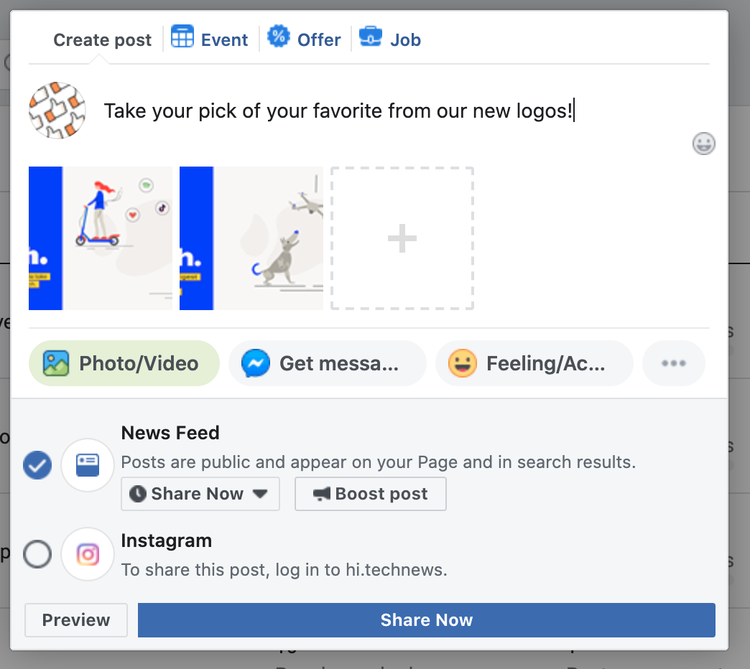
Facebook options allow brands to get creative with their marketing tactics. Image source: Author
Within this interface, you can create content, post an event, or list a job. For our purposes, we want to create a traditional Facebook post for our brand’s audience.
Facebook now offers a range of content options, including posts that feature multiple videos.
Consider your marketing metrics and any social listening data you have. These sources should keep you on track, and allay your temptation to play around with all the new Facebook tools. Don’t lose sight of the real reason we are posting on Facebook.
Tips for creating a post
Keep these tips in mind when creating the content for your Facebook post.
- Use original content: Use your own, original content in posts rather than stock images. Audiences are exposed to a lot of visual stimuli already. Make sure yours is unique.
- Mix up images and videos: Facebook offers a range of options for image and video posting: slideshows, multiple videos, and even 3D images. Make use of these opportunities, rather than posting text-only status updates.
Step #2: Set your date and time
Once you have populated the content, move on to scheduling the post.
As in the image below, select the Schedule option to open up the calendar interface.
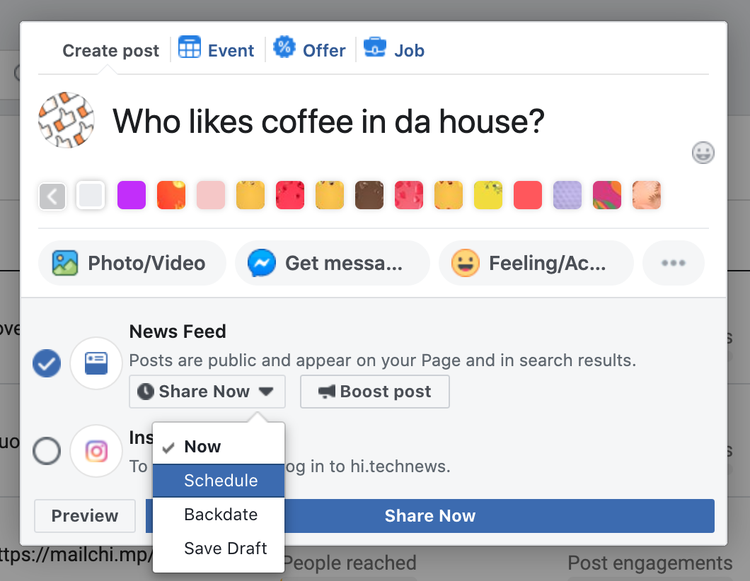
Clicking the Schedule option allows you to plan your posts far in advance. Image source: Author
Facebook can advise you on the best times to post, via the Page Insights section of your company’s page. These trends can be counterintuitive and show just how prevalent Facebook is in everyday life. Many people use social media in the workplace, on their journey to work, and at home in the evenings.
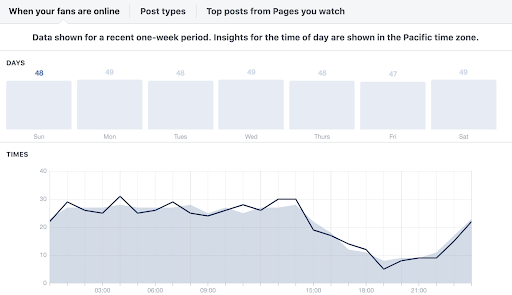
Facebook’s Page Insights tool is a handy way to see when you should post. Image source: Author
Next, all you need to do is select the time and day for the post to go live, and Facebook or your third-party post scheduler will take care of the rest.
Tips for setting your date and time
Selecting the right time to go live can make the difference between a great post and an underwhelming one.
- Spend time on your timing plan: Post when your followers are online and active on Facebook. This makes a huge difference to your campaign performance.
- Consider how often to post: There is no uniform rule for how often you should post to Facebook, but every audience will have a clear behavioral pattern. Look at your data and test a couple of different schedules. You will start to see some clear trends that can shape your future activity.
Step #3: Revisit the plan before it goes live
It’s tempting to “set and forget” with your automated posts, but err on the side of caution here.
Should an unexpected event change the market considerably, adapt your communication strategy. Many brands have been caught out by this, scheduling posts in advance and forgetting to tweak the tone when the climate takes a turn.
For example, after news events with a negative impact on people’s everyday lives, it’s best not to go with a jovial tone that promotes conspicuous consumption. Whether you work in retail marketing, restaurant marketing, or dental marketing, be ready to adapt at all times.
Tips for revisiting your plan
Follow these tips to make sure your automated posts are the right fit for your audience.
- Set up alerts for key trends: Keep up to date with stories that might affect your content strategy by setting up Google Alerts. If a significant event occurs, you can head straight to your post scheduler to amend your plan.
- Pay attention to the little details: If you make big changes to your posts, for example to the videos or images you plan to share, ensure that any accompanying details still align with the message. This could mean updating opening times if you focus on local marketing, or details of any offers you wish to promote.
Step #4: Monitor performance and optimize
Watch your marketing analytics dashboard closely to see how well your automated posts are performing against your core social media metrics.
Automating your posts lets you focus your efforts on the more challenging aspects of your marketing strategy. Make changes to your messaging and set up small A/B tests to compare post performance across different audience segments.
Tips for monitoring performance and optimizing
Bear these points in mind when assessing your social media marketing performance.
- Set targets: It can be difficult to know if your social media strategy is going as well as it could be. You have many metrics at your disposal, but what does ‘good’ look like? As such, it’s best to set your targets for each campaign, based on your business objectives.
- Change course along the way: Don’t be afraid to tweak your automated posts if data suggests another tactic would work better. Your automated schedule is not set in stone, so use this to your advantage.
The best social media management tools for scheduling your Facebook posts
These social media management tools will take the stress out of your Facebook posting schedule.
1. Sprout Social
Sprout Social schedules Facebook posts, plus a lot more and is an excellent choice.

Sprout Social’s social listening templates will help you decide which topics to focus on in your Facebook posts. Image source: Author
It provides much additional data to fuel your social media strategy, and the automated post scheduler gets high marks from users.
2. Hootsuite
Hootsuite made its name as a Twitter and Facebook post scheduler and it still excels in this arena.
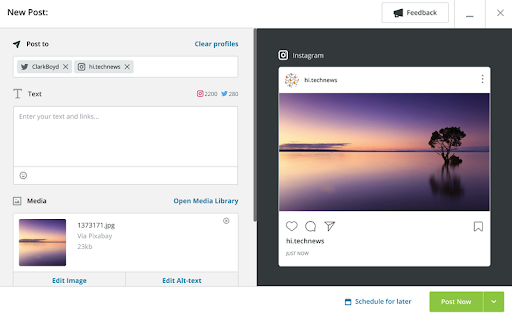
Hootsuite is a superb choice for companies that need to automate a large number of social media posts. Image source: Author
Hootsuite has also added support for over 35 other social networks and developed proprietary tools to help improve the quality of your content.
3. Gain
Gain is the best tool out there for managing complex content approval processes. Users can share files within the platform and assign tasks, so you can get your posts scheduled as seamlessly as possible. It’s designed with teams in mind.
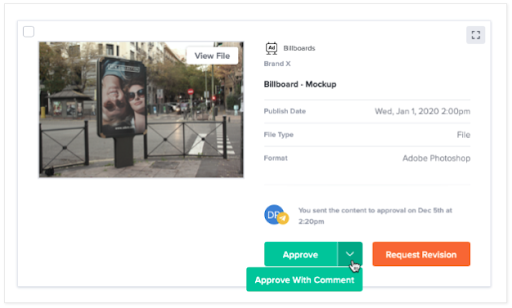
Gain’s content approval tools are innovative and they solve some enduring problems. Image source: Author
For companies that require numerous levels of approval before they can hit that Schedule button, Gain provides a lot of benefits.
Why to schedule Facebook posts
Scheduling Facebook posts is a marketing 101 strategy today, given the need to post regularly to a varied online audience. It’s too time-consuming to manually post every piece of content.
But time efficiencies aren’t the only benefit of automation. Automated scheduling frees you up to set out a future strategy that caters to a variety of audience segments, across geographies, and in a consistent tone of voice.
Following the steps outlined above will create new opportunities for both efficiency and growth within your marketing strategy.
Alert: our top-rated cash back card now has 0% intro APR until 2025
This credit card is not just good – it’s so exceptional that our experts use it personally. It features a lengthy 0% intro APR period, a cash back rate of up to 5%, and all somehow for no annual fee! Click here to read our full review for free and apply in just 2 minutes.
Our Research Expert
We're firm believers in the Golden Rule, which is why editorial opinions are ours alone and have not been previously reviewed, approved, or endorsed by included advertisers. The Ascent does not cover all offers on the market. Editorial content from The Ascent is separate from The Motley Fool editorial content and is created by a different analyst team.
Related Articles
View All Articles